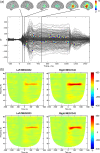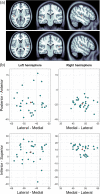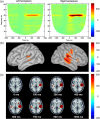The age-related changes in 40 Hz Auditory Steady-State Response and sustained Event-Related Fields to the same amplitude-modulated tones in typically developing children: A magnetoencephalography study
- PMID: 35833318
- PMCID: PMC9812253
- DOI: 10.1002/hbm.26013
The age-related changes in 40 Hz Auditory Steady-State Response and sustained Event-Related Fields to the same amplitude-modulated tones in typically developing children: A magnetoencephalography study
Abstract
Recent studies have revealed that gamma-band oscillatory and transient evoked potentials may change with age during childhood. It is hypothesized that these changes can be associated with a maturation of GABAergic neurotransmission and, subsequently, the age-related changes of excitation-inhibition balance in the neural circuits. One of the reliable paradigms for investigating these effects in the auditory cortex is 40 Hz Auditory Steady-State Response (ASSR), where participants are presented with the periodic auditory stimuli. It is known that such stimuli evoke two types of responses in magnetoencephalography (MEG)-40 Hz steady-state gamma response (or 40 Hz ASSR) and auditory evoked response called sustained Event-Related Field (ERF). Although several studies have been conducted in children, focusing on the changes of 40 Hz ASSR with age, almost nothing is known about the age-related changes of the sustained ERF to the same periodic stimuli and their relationships with changes in the gamma strength. Using MEG, we investigated the association between 40 Hz steady-state gamma response and sustained ERF response to the same stimuli and also their age-related changes in the group of 30 typically developing 7-to-12-year-old children. The results revealed a tight relationship between 40 Hz ASSR and ERF, indicating that the age-related increase in strength of 40 Hz ASSR was associated with the age-related decrease of the amplitude of ERF. These effects were discussed in the light of the maturation of the GABAergic system and excitation-inhibition balance development, which may contribute to the changes in ASSR and ERF.
Keywords: 40 Hz Auditory Steady-State Response; age-related changes; amplitude-modulated tones; auditory gamma oscillations; children; magnetoencephalography (MEG); sustained Event-Related Fields.
© 2022 The Authors. Human Brain Mapping published by Wiley Periodicals LLC.
Conflict of interest statement
The authors have no conflict of interest to report.
Figures







Similar articles
-
Translating Adult Electrophysiology Findings to Younger Patient Populations: Difficulty Measuring 40-Hz Auditory Steady-State Responses in Typically Developing Children and Children with Autism Spectrum Disorder.Dev Neurosci. 2016;38(1):1-14. doi: 10.1159/000441943. Epub 2016 Jan 6. Dev Neurosci. 2016. PMID: 26730806 Free PMC article.
-
Neuromagnetic 40 Hz Auditory Steady-State Response in the left auditory cortex is related to language comprehension in children with Autism Spectrum Disorder.Prog Neuropsychopharmacol Biol Psychiatry. 2023 Mar 2;122:110690. doi: 10.1016/j.pnpbp.2022.110690. Epub 2022 Dec 5. Prog Neuropsychopharmacol Biol Psychiatry. 2023. PMID: 36470421
-
A novel type of auditory responses: temporal dynamics of 40-Hz steady-state responses induced by changes in sound localization.J Neurophysiol. 2008 Sep;100(3):1265-77. doi: 10.1152/jn.00048.2008. Epub 2008 Jul 16. J Neurophysiol. 2008. PMID: 18632891
-
Neuronal imbalance of excitation and inhibition in schizophrenia: a scoping review of gamma-band ASSR findings.Psychiatry Clin Neurosci. 2022 Dec;76(12):610-619. doi: 10.1111/pcn.13472. Epub 2022 Oct 13. Psychiatry Clin Neurosci. 2022. PMID: 36069299
-
The influence of novelty detection on the 40-Hz auditory steady-state response in schizophrenia: A novel hypothesis from meta-analysis.Prog Neuropsychopharmacol Biol Psychiatry. 2024 Dec 20;135:111096. doi: 10.1016/j.pnpbp.2024.111096. Epub 2024 Jul 17. Prog Neuropsychopharmacol Biol Psychiatry. 2024. PMID: 39029650 Review.
Cited by
-
Comparable 40 Hz auditory steady-state responses in children at familial high risk for schizophrenia or bipolar disorder and population-based controls.Neuroimage Clin. 2025 Jul 4;48:103841. doi: 10.1016/j.nicl.2025.103841. Online ahead of print. Neuroimage Clin. 2025. PMID: 40639285 Free PMC article. No abstract available.
-
Effect of transcranial direct current stimulation on the functionality of 40 Hz auditory steady state response brain network: graph theory approach.Front Psychiatry. 2023 Jun 9;14:1156617. doi: 10.3389/fpsyt.2023.1156617. eCollection 2023. Front Psychiatry. 2023. PMID: 37363170 Free PMC article.
-
Phase Locking of 40 Hz Auditory Steady State Responses Is Modulated by Sensory Predictability and Linked to Cerebellar Myelination.Hum Brain Mapp. 2025 Apr 1;46(5):e70178. doi: 10.1002/hbm.70178. Hum Brain Mapp. 2025. PMID: 40172034 Free PMC article.
-
Abnormalities in both stimulus-induced and baseline MEG alpha oscillations in the auditory cortex of children with Autism Spectrum Disorder.Brain Struct Funct. 2024 Jun;229(5):1225-1242. doi: 10.1007/s00429-024-02802-7. Epub 2024 Apr 29. Brain Struct Funct. 2024. PMID: 38683212
-
Brain oscillatory activity evoked by chirp modulated tones in healthy children.Heliyon. 2024 Nov 23;10(24):e40599. doi: 10.1016/j.heliyon.2024.e40599. eCollection 2024 Dec 30. Heliyon. 2024. PMID: 39759314 Free PMC article.
References
-
- Arutiunian, V. , Lopukhina, A. , Minnigulova, A. , Shlyakhova, A. , Davydova, E. , Pereverzeva, D. , Sorokin, A. , Tyushkevich, S. , Mamokhina, U. , Danilina, K. , & Dragoy, O. (2022). Language abilities of Russian primary‐school‐aged children with autism spectrum disorder: Evidence from comprehensive assessment. Journal of Autism and Developmental Disorders, 52, 584–599. 10.1007/s10803-021-04967-0 - DOI - PubMed
Publication types
MeSH terms
Substances
LinkOut - more resources
Full Text Sources

